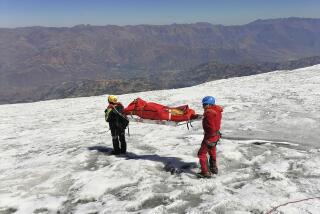When the Desert Yields Its Grisly Clues to Murders
PALM SPRINGS â It was an idyllic desert scene: blue skies, giant windmills and a hiker with his two dogs exploring the lonely, wind-scrubbed area near the freeway north of town.
Law enforcement officials say what happened next is far too common in the Coachella Valley and beyond. The hiker stumbled upon a human skull, the only remains of a murdered mother of two who had vanished two years earlier from Cathedral City.
âThereâs a saying out here that if all the dead bodies got up, weâd have enough people for another city,â said Carl Carter, a Riverside County sheriffâs homicide detective who has worked in the desert for 25 years and estimates that a quarter of his cases have been body dumps.
The open stretches of desert just off Interstate 10 in Riverside County and Interstate 15 in San Bernardino County have long been a dumping ground for people who commit crimes as far away as Los Angeles and Las Vegas.
The freeways offer a quick getaway, and the harsh elements often turn a body into a skeleton within two weeks, leaving few clues for authorities who find the remains days or even years later.
âOnly 250,000 people live in [the Coachella Valley] year-round, but itâs pretty consistent that every week someoneâs finding a body,â said California Highway Patrol Lt. Bill Elliott, who is stationed in Indio.
To help identify the bodies, the Riverside County coronerâs office recently began putting information and, when possible, pictures on its Web site: https://www.co.riverside.ca.us/sheriff/coroner/unidentified/96052.htm. There are 16 victims listed, about half of them unidentified bodies found in the desert. Those are probably murder victims or perhaps immigrants or transients traveling without documentation who succumbed to the elements, said Rick Bogen, Riverside senior deputy coroner.
But he said the numbers tell only part of the story. âNot all bodies go on the Web. We have pieces of skull and bones that were out there for years. Thereâs no way anyoneâs going to be able to identify them.â
Still, he said, itâs amazing how many John and Jane Does investigators are able to identify. Sometimes thereâs a break. âWeâve had people who had been tied up, burned, dumped and we turned them over and they had a wallet with ID in their pocket,â Bogen said.
Other times detectives begin with nothing more than bleached bones scattered by coyotes.
For those cases, the coronerâs office calls in Deborah Gray, a Riverside forensic anthropologist who has helped identify bodies using such clues as the serial number on a metal hip replacement or the brand of silicone gel breast implant that survived after someone torched a womanâs body.
From skeletal remains, Gray can usually give detectives the height, age and sex of a victim and sometimes other key details. In one case, she was able to tell--from only a few bones--that the victim had been a serious bodybuilder.
The body with the metal hip was found in scrubby desert near Temecula in 1997. The victim had been buried deeply enough that animals had not unearthed his body, but the job was done in haste, so the sunken grave was visible to a hiker.
As she worked with investigators to dig up the body, Gray figured the grave was about 3 years old, and a detective on the scene immediately said: âI bet itâs Marty.â
He was right.
Marty Alstaetter, 59, had fallen from a ladder and broken his hip, which was replaced with metal pins. There had been an insurance settlement. A short time later, neighbors reported him missing. When investigators went to the Norco home that Alstaetter had shared with two roommates, they found blood on the walls that hadnât been washed off, just painted over, and blood on the floors. Investigators were sure Alstaetter was dead, but with no body, there were no arrests in the 1994 disappearance.
Three years later, Gray heard a ping as she aimed a metal detector near the hip of the unidentified body still in the ground. Investigators later compared Alstaetterâs medical records with the metal pins and confirmed his identity.
Detectives confronted one of the roommates, who confessed and who was still sleeping on the pale blue fitted sheet that matched the top sheet used to wrap Alstaetterâs body, Gray said.
Finding a body and getting a positive identification are the groundwork for any arrest. A body thatâs misidentified can cost investigators precious time.
During a routine inventory of bones in 1996, Gray and other investigators came upon 17-year-old bones labeled as those of a young girl. They noted that the bones had not gone through the changes of puberty, meaning that the victim could have been a boy. One detective immediately thought of Jamie Trotter, a 13-year-old Costa Mesa boy who had disappeared in 1979. An orthodontist later matched pieces of braces found at the site to identify Jamie.
Detectives discovered that the hiker who led them to the bones in 1990 was James Lee Crummel, a sex offender in custody on 15 new molestation charges. Crummel was convicted of the boyâs murder.
Thereâs been no such resolution to the mystery that began in 1995 when a couple stumbled upon the body of Marie Darling, a vivacious elderly widow whose remains were found east of Indio. She had vanished from her Palm Springs home two months earlier.
Det. Carter has been working the case ever since. The physical evidence was badly ravaged, but Carter said he still hopes that some new information will surface to help him make a case.
âThe desert is an unforgiving environment. It erases. Body dumps here are more difficult to solve than smoking-gun urban murders,â Carter said. âThe evidence has been hidden for years or disappeared. Defendants have longer to concoct alibis and get out of town.â
Randy Emon, San Bernardino Countyâs supervising deputy coroner, said there arenât precise statistics on how many bodies have been found in the desert. But, he said, thatâs not the most important question.
âThe real question is: How many more are out there?â
More to Read
Sign up for Essential California
The most important California stories and recommendations in your inbox every morning.
You may occasionally receive promotional content from the Los Angeles Times.











